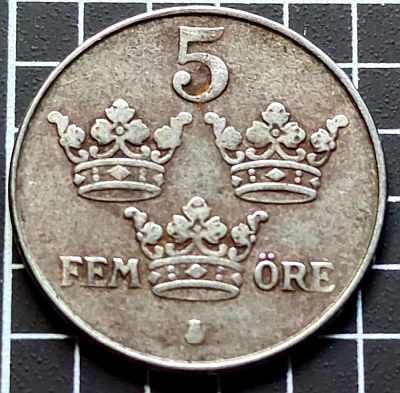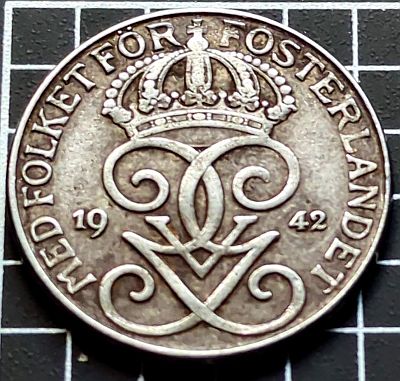An iron Tre Kronor
Reverse

The reverse of the coin features the value, in number and text. “FEM” = “FIVE” in Swedish. The lump at the bottom is the Stockholm mint’s mintmark. The mintmark, like the 1956 5 Öre covered previously depicts the crowned St Eric IX of Sweden.
The main element on the reverse is the Tre Kronor, or “Three Crosses”. The Tre Kronor has been the official emblem of Sweden since the 1300s. The exact origin of the three crowns is debated. Albrekt of Mecklenburg is widely credited with creating the symbol as a sign of his rule over Sweden, Finland and Mecklenburg. However he ruled 1364-89. However, a frieze in Avignon, France dates to 1336 and was painted for an international congress led by Pope Benedict XII. This frieze contains the symbols of all participant countries including the three crowns of Sweden. This dates the introduction of the symbol to no later than Albrekt’s predecessor, Magnus Eriksson (1316–74). Eriksson styled himself King of Sweden, Norway and Scania. Hence three crowns. The three crowns was also used by the Kalmar Union, a joining of Sweden, Denmark and Norway. Denmark was angered when Sweden started using the three crowns as a national symbol, and this was also a contributing factor to the Northern Seven Year’s War.
Whatever the full history, the symbol is now commonly associated with Sweden and has been used on everything from the Stockholm City Hall, to the Swedish Air Force Roundel and the Swedish Police insignia.
Obverse

The obverse contains the text “MED FOLKET FÖR FOSTERLANDET” around the edge. This is the King Gustaf V’s personal motto, which translates to English as “With the people for the Fatherland“.
In the center, the date divides the King’s double GGV monogram.
Essentially the same design was used on the 5 Öre from 1909. Originally, the coins were bronze. Following shortages during WWII, the 1, 2 and 5 Öre coins from 1942 – 1950 were minted from Iron.

Image of Iron 1, 2 and 5 Öre coins, and a 1909 5 Öre coin in brass (lower right).


Leave a Reply